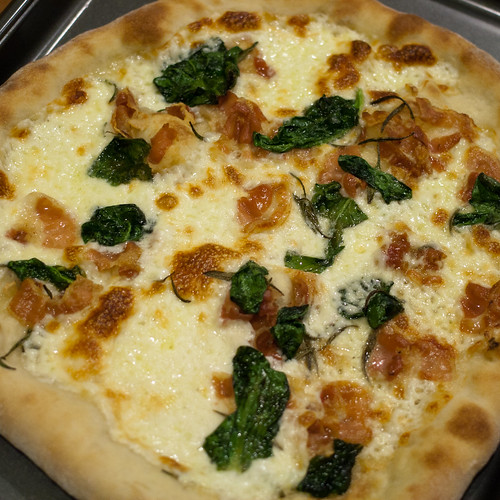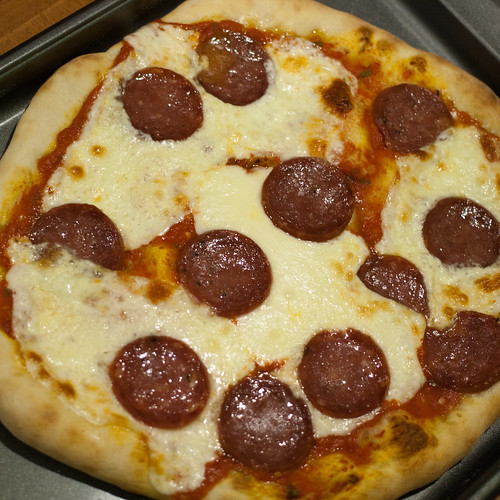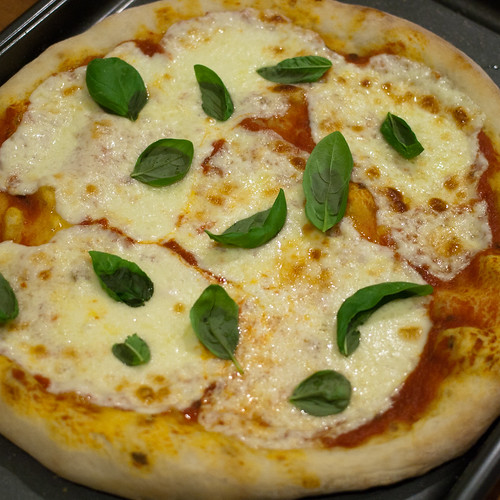In my pursuit of perfect pizza—making and eating it—I decided that I'm going to have pizza night once a week at my place. This will provide me with consistent pizza making practice and with an environment where I benefit from the feedback from others. This post is about the pizzas I made last Wednesday.
For the past year I've been using a great dough recipe that I found in an issue of Cook's Illustrated. Lately I've been following J. Kenji Lopez-Alt's pursuits of making great pizza at home on seriouseats.com, so this week I tried his basic New York-style pizza dough instead of the Cook's Illustrated recipe.
I think I like the CI dough a bit better, but because they're so similar, I'm going to keep trying Kenji's dough and tamper with that till I can get the crust I want. Both doughs require mixing in a food processor. My food processor is too small to handle a lump of pizza dough so I used my stand mixer. According to Kenji, prolonged exposure to oxygen during kneading will adversely effect the flavor of the dough. For most doughs, the kneading process to develop gluten can take quite a bit of time. A food processor is recommended because the fast-spinning blade can knead the dough in 30 seconds. I might consider purchasing a larger food processor in the future.
Like the CI dough, Kenji's dough requires a rise in the refrigerator of at least 24 hours. I kept my dough in the fridge for the minimum time period. I'm going to let my next batch of dough ferment a little longer, maybe two or three days.
My first creation was a white pie:
I topped this guy with a bit of olive oil, roasted garlic, a ton of mozzarella, rosemary, lightly sauteed spinach, and pancetta. Pancetta comes my favorite part of the pig, the belly. It's almost the same thing as bacon; where bacon is smoked, pancetta is not (it's sometimes referred to as Italian bacon). I prefer pancetta to bacon, especially on pizza. I'm not sure how much the spinach adds to this pizza so I will reconsider that the next time I make it. This pizza turned out great.
I have yet to make a tomato sauce that I totally love. I wanted to keep the sauce simple, so I processed a can of whole San Marzano tomatoes with salt and fresh oregano. I added some sugar to temper the acidic tomatoes, but ended up adding too much, which killed much of the sauce's brightness. The oregano didn't add much unless you bit into one of the small leaves and then it was almost too flavorful. Next time I will use an actual recipe (like this one) and add or subtract to that instead of winging it.
I topped the pizza above with tomato sauce, mozzarella, and soppresatta (salami). The soppresatta had a great flavor but I sliced it a little too thick, and as a hard salami, so it was tough to bite through. Next time I'll try to find a pre-sliced soppresatta. I wanted to throw some olives on this pie but I couldn't find any that looked like the right quality. Again, something else to look for.
This one was my attempt at a Margherita pizza: tomato sauce, mozzarella, and basil. It was my least favorite. Just too bland. Besides getting the crust right (which I didn't on this pie), I feel like the key to a good Margherita is the sauce, which as I explained, was not the forte of this week's pizza making.
All three pies were baked at 500°F on a pizza stone on the top rack of the oven. (Really looking forward to trying my new Baking Steel next week.)
Other notes and things to try next time:
— Look into investing in a large food processor.
— Leave the dough in the fridge for two to three days.
— Using the same dough recipe, make four or five smaller pies instead of three large-ish ones. I had a hard time making the dough consistently thin. Smaller pies will make this easier until I get better at it.
— Find some pre-sliced soppresatta.
— Go easy on the cheese. I didn't think the phrase "too much cheese" had a place in my vocabulary. After these three pizzas I was sad to discover that it does.
— Keep the pizza in the oven longer and rotate earlier for even browning.




This looks incredible. Even if I can't eat it, I still support these pizza happenings.
ReplyDeleteKeeping them small can also help you have enough dough to try different pizzas in one night, or in subsequent nights. And I agree on your point about the Margherita; since it’s a very minimalistic pizza, the sauce will carry a lot of its weight in terms of taste.
ReplyDeleteCarlene @ Incredible Pizza
I love Margherita! I used to make one of these, with lots of tomatoes in it. I'm pretty sure you'll also love the taste. Regarding the crust, you can use a rolling pin to make it thinner. Though it requires more effort, it's all worth it. By the way, I'm not against smaller pizzas. :)
ReplyDeleteIncrediblePizzaDesMoines.com